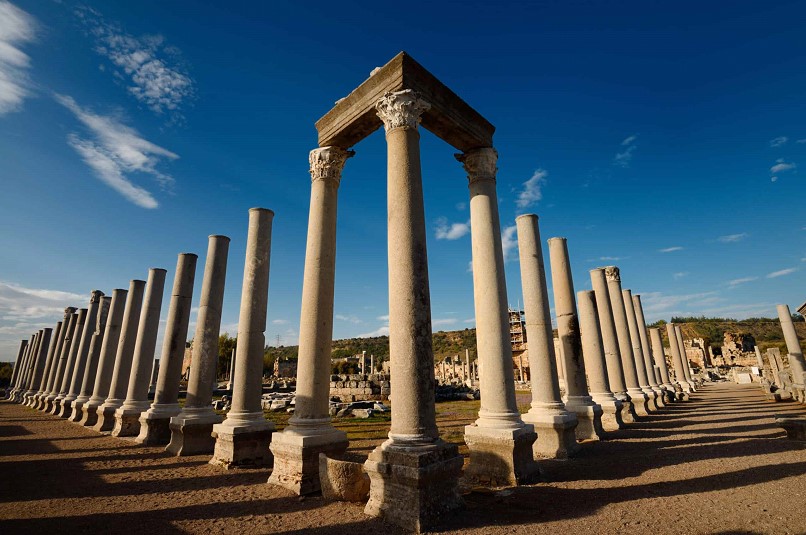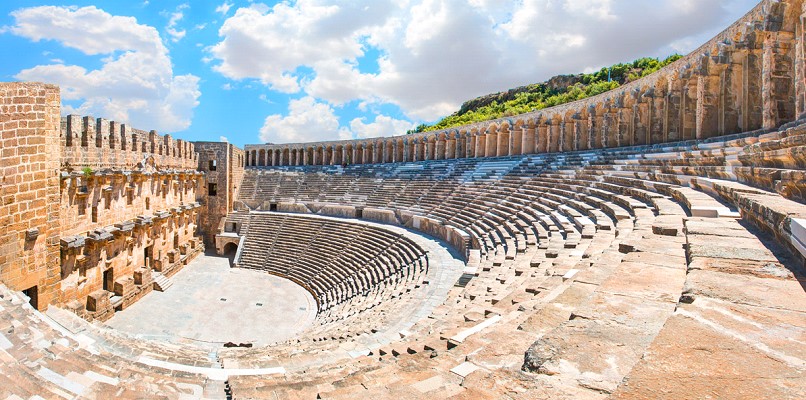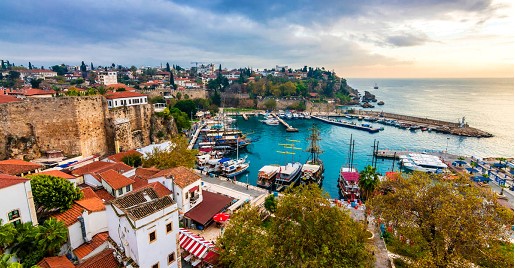Tour
Historical Places Tour
*The tour will be accompanied by a professional guide.
* Entrance fee to the museums belongs to the participants.
* Soft launch and drinks will be provided for participants staying at Grand Park Lara Hotel.
09:00 The Tour starts from The Conference Hotel.
Kurşunlu Waterfall

The Kurşunlu Waterfall (Turkish: Kurşunlu Şelalesi) is located 19 km from Antalya, Turkey at the end of a 7 km road branching off to the north of the Antalya-Serik-Alanya highway at a point 12 km east of Antalya. It is reduced to a mere trickle in the summer months.
The waterfall is on one of the tributaries of the Aksu River, where the tributary drops from Antalya’s plateau to the coastal plain. It is situated in the midst of a pine forest of exceptional beauty, and the environs provide a picnic and pleasure spot about twenty minutes by car from the centre of the city of Antalya.
The waterfall and its surroundings covering an area of 586.5 ha (1,449 acres) was declared a nature park by the Ministry of Environment and Forest on May 21, 1991.
All year round, safari tours with all-terrain vehicles are being organized near the waterfall.
Perga

Perga or Perge (Hittite: Parha, Greek: Πέργη Perge, Turkish: Perge) was originally an ancient Lycian settlement that later became a Greek city in Pamphylia. It was the capital of the Roman province of Pamphylia Secunda, now located in Antalya Province on the southwestern Mediterranean coast of Turkey. Today its ruins lie 15 kilometres (9.3 mi) east of Antalya.
It was the birthplace of the Greek mathematician Apollonius of Perga, one of the most notable mathematicians of antiquity for his work on conic sections. A unique and prominent feature for a Roman city was the long central water channel in the centre of the main street which contained a series of cascading pools and which would have been remarkable even today in a semi-arid area where summer temperatures reach over 30 degrees Celsius.
Aspendos

Aspendos or Aspendus (Pamphylian: ΕΣΤϜΕΔΥΣ; Attic: Ἄσπενδος) was an ancient Greco-Roman city in Antalya province of Turkey. The site is located 40 km east of the modern city of Antalya.
It was situated on the Eurymedon River about 16 km inland from the Mediterranean Sea; it shared a border with, and was hostile to, the ancient city of Side.
The wide range of its coinage throughout the ancient world indicates that, in the 5th century BC, Aspendos had become the most important city in Pamphylia. At that time, according to Thucydides, the Eurymedon River was navigable as far as Aspendos, and the city derived great wealth from a trade in salt, oil and wool.
Aspendos did not play an important role in antiquity as a political force. Its political history during the colonisation period corresponded to the currents of the Pamphylian region. Within this trend, after the colonial period, it remained for a time under Lycian hegemony. In 546 BC, it came under Persian domination. The fact that the city continued to mint coins in its own name, however, indicates that it had a great deal of freedom even under the Persians.
Circa 465 BC, Cimon led an Athenian navy against a Persian navy in the Battle of the Eurymedon, and destroyed it. Aspendos then became a member of the Delian League.
The Persians captured the city again in 411 BC and used it as a base. In 389 BC, Thrasybulus of Athens, in an effort to regain some of the prestige that city had lost in the Peloponnesian Wars, anchored off the coast of Aspendos in an effort to secure its surrender. Hoping to avoid a new war, the people of Aspendos collected money among themselves and gave it to the commander, entreating him to retreat without causing any damage. Even though he took the money, he had his men trample all the crops in the fields. Enraged, the Aspendians stabbed and killed Thrasybulus in his tent.
When Alexander the Great marched into Aspendos in 333 BC after capturing Perge, the citizens sent envoys asking him not to garrison soldiers there. He agreed, provided he would be given the taxes and horses that they had formerly paid as tribute to the Persian king. After reaching this agreement Alexander went to Side, leaving a garrison there on the city’s surrender. Going back through Sillyon, he learned that the Aspendians had failed to ratify the agreement their envoys had proposed and were preparing to defend themselves. Alexander marched to the city immediately. When they saw Alexander returning with his troops, the Aspendians, who had retreated to their Acropolis, again sent envoys to sue for peace. This time, however, they had to agree to very harsh terms; a Macedonian garrison would remain in the city and 100 gold talents as well as 4,000 horses would be given in tax annually.
In 190 BC, the city surrendered to the Romans, and the corrupt magistrate Verres later pillaged its art treasures. It was ranked by Philostratus the third city of Pamphylia, and in Byzantine times seems to have been known as Primopolis. Toward the end of the Roman period the city began a decline that continued throughout Byzantine times, although in medieval times it was evidently still a strong place.
Diogenes Laërtius writes that there was a native of Aspendos called Demetrius, who was a pupil of Apollonius of Soli. In addition, he mentions Diodorus of Aspendus.
15:00-18:00 Old Town Shopping





